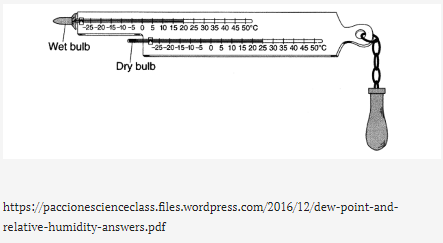Dew Point & Relative Humidity Activity - Tweaked for 9th- 12th Grade ;)
This article is part of the “LP Tweaks” blog series showcasing how small adjustments to the questions, organization, and/or data moves within your existing curriculum can help align the learning to different data skills for your learners. This original lesson is strong, and the intention is not to communicate otherwise but rather to share how you could adjust things for a different desired outcome.
Written by: Naomi W

Let’s imagine your students are struggling with HS- ESS2-4, “Use a model to describe how variations in the flow of energy into and out of Earth’s systems result in changes in climate”. So you go looking for some new approaches to it and you come across a great data-based lesson using scientific data on Atmospheric Measurements: Dew Point & Relative Humidity (answer key available here). You are excited about how this lesson could help them use the data to understand how air temperature and relative humidity vary throughout the day and how that relates to weather patterns.
However, based on your student's performance in the last unit you are looking to give them more time to “Interpret patterns in context” in a practiced way to deepen their skills around “understanding of what nonlinear relationships mean in context” (see Building Blocks for Data Literacy to explore the corresponding data skills of these areas more).
You are torn, you like the Dew Point and Relative Humidity lesson to help students dive into the relationships among air temperature, time of day, and relative humidity. But, you are worried the questions aren’t directly getting at the data skills your learners need to practice at this point in the year, but the content is. What do you do?
Let’s check out some easy optional tweaks to make the lesson more what you are looking for now for your students. Here is an example of how we can add a few questions to the lesson to more directly help your current students practice data skills we know they are weaker on (or we are more interested in targeting this specific data interaction) at this point in the year.

For example, the lesson includes a visual model diagram of different air samples capacity to hold water vapor. The existing questions ask students to read the diagram and then jump into interpretation. However, given that your students are needing help to think about the context of the data…it could be helpful to add prompting questions to encourage deeper thinking about the diagrams. These new questions will help the students get a better understanding of the model diagram they are looking at so that they can more deeply explore the concepts in the diagram and in the subsequent data.
With a broader understanding of the concepts they are exploring, students then can dive deeper into analyzing and understanding the relationships between temperature, dew point, and relative humidity. Specifically, you are interested in your students being able to “understand what nonlinear relationships mean in context” in grades 9-12 in appropriate ways.

These added questions are explicitly designed to help the students dive deeper into how to read the given data to better understand nonlinear relationships in data within the context of what they are looking at. For example, the questions in number 3 do not add a lot of time, but are critical aspects of students looking at the data and being able to interpret it according to the larger concepts. Asking students for the correlation and/or relationship on these data – inversely cyclical – is a great way to deepen their understanding of not only this concept but that many patterns observed in nature are non-linear.
Therefore, with the addition of 4 new suggestions, you can start using this new lesson you found while also better aligning it with your current learners' needs and/or your desired focus areas for your learners to practice data skills. To me, that feels like a win-win…using a lesson that you like with a more strategic data focus to help learners build their skills :)
As a note, be sure when students are looking at data from multiple variables on the same graph that they are able to and actually are differentiating between the different types of variables. It is easy for students to look at double y-axis graphs like this and want to compare air temperature with relative humidity immediately. But that is not what this graph displays. If your students are struggling with this, then consider making it for them or asking them to make separate plots for each relationship (e.g., time of day vs air temperature, time of day vs relative humidity) and then comparing the two graphs to one another.

